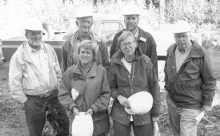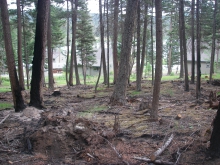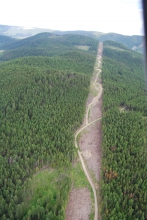 Welcome to the second issue of Eye on B.C.’s Forests, the Forest Practices Board’s newsletter. Eye on B.C.’s Forests provides an overview of the Board’s recent work, including trends and issues analysis and previews of upcoming reports and projects. Eye on B.C.’s Forests is distributed to our e-mail subscribers, as well as posted on our website. We hope you find this Eye on B.C.’s Forests of value and interest, and we appreciate feedback. Please send comments and suggestions about Eye on B.C.’s Forests to FPBoard@gov.bc.ca.
Welcome to the second issue of Eye on B.C.’s Forests, the Forest Practices Board’s newsletter. Eye on B.C.’s Forests provides an overview of the Board’s recent work, including trends and issues analysis and previews of upcoming reports and projects. Eye on B.C.’s Forests is distributed to our e-mail subscribers, as well as posted on our website. We hope you find this Eye on B.C.’s Forests of value and interest, and we appreciate feedback. Please send comments and suggestions about Eye on B.C.’s Forests to FPBoard@gov.bc.ca.
New Board member, Al Gorley, was appointed by the Provincial Cabinet in November 2009, replacing Guenter Stahl who concluded his second term on the Board in October. Al Gorley has previously worked with the BC forest service, serving as district manager in Houston, regional manager in Prince George, and assistant deputy minister of business initiatives in Victoria. Currently president of consulting firm Triangle Resources Incorporated, Al works on strategic planning, project facilitation and natural resource policy. Al also spent three years with Forest Renewal BC (Chief Operating Officer from 2000 to 2002), and worked with both the McGregor Model Forest Association and the Canadian Model Forest Network. Al is a past member and Chair of the Board of Directors for Northwest Community College, served on the ABCFP Council for four years, and, more recently, was a member of the province's Environmental Appeal Board and Forest Appeals Commission. Members John Dunford, Rachel Holt, and Debbie Zandbelt were re-appointed for a second term. And the search for a new Board Chair is underway, as Dr. Bruce Fraser will be stepping down after 6 ½ years service in April 2010.
 It was 15 years ago this December that the very first Forest Practices Board was appointed. On December 21, 1994, Chair Keith Moore and members Dr. Gordon Baskerville, Cathy Mumford, Cindy Pearce and Jack Toovey were appointed, joined by Clay Perry the following March. It was six months before the legislation would come into force. With little more than a briefcase, Chair Keith Moore and his board members set about creating the organization. A first of its kind, it was no simple task to create the policies, programs, and procedures, recruit the experienced staff and get the organization off the ground. When the Forest Practices Code was proclaimed and came into effect in June 1995, the board was ready for a flood of complaints to come in the door. While that flood never materialized, there has been a steady influx of complaints, an audit program was developed and implemented, and administrative appeals, special investigations and special reports on forestry matters all began to take shape. Since those humble beginnings, 29 individuals have served on the Board, including three different chairs, bringing a tremendous breadth of experience from across British Columbia, and the forestry and environmental sectors, to bear on the organization. Since 1995, the Forest Practices Code was streamlined and then completely replaced by the Forest and Range Practices Act. A full audit program has been developed, conducting well over 120 audits of forest and range licensees and government agencies throughout the province. A steady stream of complex and difficult complaints from the public have been dealt with each year, leading to over 150 published reports. Two dozen special investigations have been undertaken by various boards to look at current forestry issues, and three dozen special reports on various topics related to the Board’s mandate have been published by the three chairs who have held office. The Board has also brought the public interest to bear in dozens of reviews and appeals of administrative determinations. For those of us who have been with the Board since the early days, it’s hard to believe it’s been 15 years already. But we remain firmly committed to continuing the vision and mission of those first few people who were appointed to carry out the mandate on behalf of the public of BC.
It was 15 years ago this December that the very first Forest Practices Board was appointed. On December 21, 1994, Chair Keith Moore and members Dr. Gordon Baskerville, Cathy Mumford, Cindy Pearce and Jack Toovey were appointed, joined by Clay Perry the following March. It was six months before the legislation would come into force. With little more than a briefcase, Chair Keith Moore and his board members set about creating the organization. A first of its kind, it was no simple task to create the policies, programs, and procedures, recruit the experienced staff and get the organization off the ground. When the Forest Practices Code was proclaimed and came into effect in June 1995, the board was ready for a flood of complaints to come in the door. While that flood never materialized, there has been a steady influx of complaints, an audit program was developed and implemented, and administrative appeals, special investigations and special reports on forestry matters all began to take shape. Since those humble beginnings, 29 individuals have served on the Board, including three different chairs, bringing a tremendous breadth of experience from across British Columbia, and the forestry and environmental sectors, to bear on the organization. Since 1995, the Forest Practices Code was streamlined and then completely replaced by the Forest and Range Practices Act. A full audit program has been developed, conducting well over 120 audits of forest and range licensees and government agencies throughout the province. A steady stream of complex and difficult complaints from the public have been dealt with each year, leading to over 150 published reports. Two dozen special investigations have been undertaken by various boards to look at current forestry issues, and three dozen special reports on various topics related to the Board’s mandate have been published by the three chairs who have held office. The Board has also brought the public interest to bear in dozens of reviews and appeals of administrative determinations. For those of us who have been with the Board since the early days, it’s hard to believe it’s been 15 years already. But we remain firmly committed to continuing the vision and mission of those first few people who were appointed to carry out the mandate on behalf of the public of BC. 
 During the summer and fall, Board auditors carried out seven new audits, looking at a variety of tenure types—including woodlots, a municipally-owned tree farm licence, a tree farm licence, and two BC Timber Sales programs—an audit of visual resources and an audit of the appropriateness of government enforcement in one forest district. A major special investigation of fuel reduction treatments in urbanwildland interface areas was also carried out early this summer. Two of the audits have been completed and published, and the remaining reports will come out in 2010.
During the summer and fall, Board auditors carried out seven new audits, looking at a variety of tenure types—including woodlots, a municipally-owned tree farm licence, a tree farm licence, and two BC Timber Sales programs—an audit of visual resources and an audit of the appropriateness of government enforcement in one forest district. A major special investigation of fuel reduction treatments in urbanwildland interface areas was also carried out early this summer. Two of the audits have been completed and published, and the remaining reports will come out in 2010.
As many of you will have noticed, nearly a dozen reports were completed and published this fall. Three major special projects wrapped up, four audits were concluded and several complaint investigations were completed. In total 30 reports were published this year. An analysis of our website visitor data reveals that the top 5 downloaded reports this year were:
This fall, the Board took the opportunity to explore the topic of road maintenance in coastal BC in some detail. Road maintenance is an important activity carried out by industry and government to ensure forest roads remain safe for industrial users, and consequently any public users. Three teams of investigators looked at dozens of road systems covering hundreds of kilometres of forest roads, in the Squamish, Campbell River and South Island Forest Districts. A report on the findings should be out in spring/summer 2010.
 It was nearly 10 years ago when the Nisga’a people of British Columbia ratified an historic agreement—the first modern treaty settlement in Canada. The Nisga’a Agreement included a 5-year transition period during which provincially authorized forestry operations on Nisga’a land would be wound down. During that transition period, forest companies with tenure in the ceded lands would continue their approved operations, and conclude any outstanding obligations they had related to roads or reforesting of harvested sites. Included in the Agreement, was a clause that said:
It was nearly 10 years ago when the Nisga’a people of British Columbia ratified an historic agreement—the first modern treaty settlement in Canada. The Nisga’a Agreement included a 5-year transition period during which provincially authorized forestry operations on Nisga’a land would be wound down. During that transition period, forest companies with tenure in the ceded lands would continue their approved operations, and conclude any outstanding obligations they had related to roads or reforesting of harvested sites. Included in the Agreement, was a clause that said:
During the transition period, the Forest Practices Board will perform an annual audit of compliance with and enforcement of forest practices legislation on Nisga'a Lands.
The purpose of the Board’s involvement was really to provide assurance to the Nisga’a people— and the people of BC and the rest of Canada— that forests that would eventually be returned to the Nisga’a were being properly managed for long-term sustainability. As a result of this commitment, the Board developed a special audit program for the Nisga’a lands, in consultation with the Nisga’a Lisims Government, and the federal and provincial governments. Annual audits were completed during the transition period, examining both compliance by government and forest companies with forestry legislation, and effectiveness of government’s enforcement of forestry legislation. During this period, the most active major licensee in the area, Skeena Cellulose, became New Skeena Forest Products, which subsequently went bankrupt, leaving numerous outstanding forestry obligations on Nisga’a land. These unfulfilled obligations were identified in Board audit reports prepared under the agreement. After the official transition period ended in May 2005, the Ministry of Forests and Range responded to New Skeena’s continuing financial troubles and began its own actions to address New Skeena’s outstanding obligations. Although the transition period, and therefore the Board’s obligation to conduct audits, ended in 2005, the Nisga’a asked the Board to continue its involvement to review the work undertaken by the Ministry of Forests to address New Skeena’s outstanding obligations. In September 2008, the Board conducted a final field review of the work done and this past November provided a report to the Nisga’a Lisims Government, thus ending our involvement with the Nisga’a treaty. In the report, the Board commends the BC government, and in particular MFR, for their commitment to, and cooperation with, the Nisga’a Nation in identifying and addressing New Skeena’s obligations. This was a very unique and valuable experience for all involved. The Nisga’a Lisims Government and the Ministry of Forests have both expressed their thanks for the Board’s involvement in identifying issues and ensuring the lands that were transferred to the Nisga’a people were in good condition from a forestry perspective. The Board was pleased to be able to contribute to the fulfillment of this historic agreement.
 The Board has received a complaint from the Sierra Club of BC and the Friends of Bute Inlet about the effect of an independent power project on forest resources on the mainland coast north of Sechelt. The project involves about 65 kilometres of new or upgraded roads and 145 kilometres of transmission lines that may impact forest resources. The Board is presently considering what jurisdiction it has over roads and transmission lines and what forestry issues it might be able to examine in response to the complaint.
The Board has received a complaint from the Sierra Club of BC and the Friends of Bute Inlet about the effect of an independent power project on forest resources on the mainland coast north of Sechelt. The project involves about 65 kilometres of new or upgraded roads and 145 kilometres of transmission lines that may impact forest resources. The Board is presently considering what jurisdiction it has over roads and transmission lines and what forestry issues it might be able to examine in response to the complaint.
 Having completed work on a couple of major projects this year, staff are now starting some new projects looking at current forestry issues. In 2008, the Board approved the second phase of the land use planning project completed last year. This new project that will look at government’s progress towards implementing biodiversity objectives, such as old growth management areas, as contained in various land-use plans. This project will also assess how government selects and tracks attributes or areas set aside for retention and circumstances when limited harvesting of these areas is permitted. At its December meeting, the Board just approved a new special investigation that will look at licensee compliance with section 86 of the Forest Planning and Practices Regulation, which requires licensees to report annually on their activities. Information on areas harvested, regenerated, and conserved, must be entered into the provincial government’s RESULTS (Reporting Silviculture Updates and Land Status Tracking System) database. The investigation will also look at the utility of the database and the information it holds for reporting on the condition of forest lands. Interviews will be conducted with database users to gain valuable perspectives on how the database might be improved to enhance data collection and reporting. The Board is also moving forward with a piece on the lessons learned from the series of work we have done on mountain pine beetle. While the MPB epidemic may have passed its peak, the Board believes there are important lessons to be learned to improve our response to future catastrophic and unpredictable events that are likely to impact our forests under a changingclimate. The Board and staff continue to monitor results of our work and other projects will continue to be identified as public interest demands and resources permit. Which of the following individuals has not been a member of the Forest Practices Board?
Having completed work on a couple of major projects this year, staff are now starting some new projects looking at current forestry issues. In 2008, the Board approved the second phase of the land use planning project completed last year. This new project that will look at government’s progress towards implementing biodiversity objectives, such as old growth management areas, as contained in various land-use plans. This project will also assess how government selects and tracks attributes or areas set aside for retention and circumstances when limited harvesting of these areas is permitted. At its December meeting, the Board just approved a new special investigation that will look at licensee compliance with section 86 of the Forest Planning and Practices Regulation, which requires licensees to report annually on their activities. Information on areas harvested, regenerated, and conserved, must be entered into the provincial government’s RESULTS (Reporting Silviculture Updates and Land Status Tracking System) database. The investigation will also look at the utility of the database and the information it holds for reporting on the condition of forest lands. Interviews will be conducted with database users to gain valuable perspectives on how the database might be improved to enhance data collection and reporting. The Board is also moving forward with a piece on the lessons learned from the series of work we have done on mountain pine beetle. While the MPB epidemic may have passed its peak, the Board believes there are important lessons to be learned to improve our response to future catastrophic and unpredictable events that are likely to impact our forests under a changingclimate. The Board and staff continue to monitor results of our work and other projects will continue to be identified as public interest demands and resources permit. Which of the following individuals has not been a member of the Forest Practices Board?
A. Bill Cafferata B. Dr. Gordon Baskerville C. Jack Munro D. John Cuthbert E. Frances Vyse F. Mark Haddock G. Darcy Mitchell
ANSWER: C. Jack Munro, former president of the International Woodworkers Association, has never served on the Forest Practices Board.
